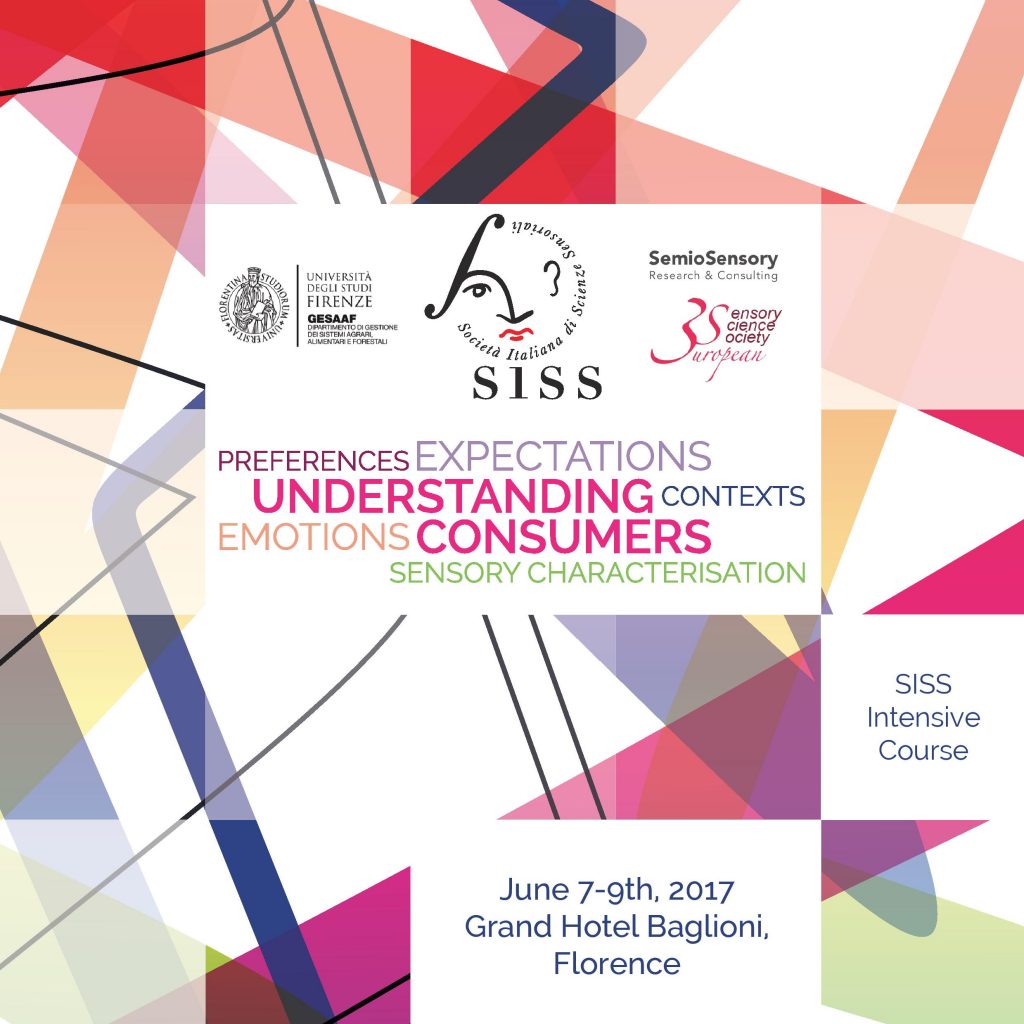
THE ITALIAN SENSORY SCIENCE SOCIETY IS PLEASED TO PRESENT A 3-DAY NEW COURSE IN SENSORY AND CONSUMER SCIENCE
The course will feature recent advances in cognitive psychology applied to sensory and consumer studies on food, beverage, cosmetic, personal care and home care products.
You will also get an overview of some of the most important methods and statistical tools that can be used for collecting and extracting useful information from sensory and consumer data.
The course will give you an updated basis for planning an experimental design, understanding your results more in depth for decisions in a commercial setting.
Level: Intermediate-Advanced
The course will cover both theoretical background, a large number of relevant examples and case studies, computer demonstrations and hands on activities.
THE COURSE IS BASED ON A MULTIDIMENSIONAL APPROACH, WITH FIVE MODULES, EACH FOCUSED ON A HOT TOPIC: CONSUMER PREFERENCES, EMOTIONS, EXPECTATIONS, CONTEXTS AND SENSORY CHARACTERISATION
The instructors
Prof. John Prescott
TasteMatters Research & Consulting, Australia
University of Florence, Italy
Prof. Erminio Monteleone
University of Florence, Italy
Dr. Gastón Ares
Universidad de la República, Uruguay
Dr. Paula Varela
Nofima, Norway
Dr. Betina Piqueras-Fiszman
Wageningen University, The Netherlands
Dr. Sara Spinelli
University of Florence, Italy
SemioSensory | Research & Consulting, Italy
Programme
Wednesday 7th June 2017
PREFERENCE & EMOTIONS
8.30 – Registration
9.00 – Introduction
9.30-10.30 – John Prescott
Explaining preferences
Theoretical background
• Psychology of consumer preferences
• Influences: exposure, familiarity, attention, learning mechanisms
10.30-11.00 – Break
11.00-12.00 – John Prescott
Measuring preferences: methods and case studies
Explicit and implicit measures of preferences
• Rating scales: applications and limitations
• Implicit methods: Implicit association task (IAT), priming
12.00-13.00 – Erminio Monteleone
Interpreting individual differences in liking
Hands on: Interpretation of preference mapping
13.00-14.00 – Lunch
14.00-15.00 – Sara Spinelli
Explaining emotions
Theoretical background
• What are emotions
• Emotions and decision-making
• Emotions and language
• What emotions are we measuring
15.00-15.30 – Break
15.30-17.00 – Sara Spinelli
Measuring emotions: methods and case studies
• Explicit measurements: verbal and visual self-reports
Standardised and product specific questionnaires; Questionnaires using words and/or images
Examples: EsSense Profile, GEOS, EmoSemio, PrEmo
• Implicit measurements: Implicit Association and Emotive Projection Test
• Measuring emotions through physiological measures (ANS)
• Measuring emotions from the brain: applied consumer neuroscience
Emotions in product development
• Emotions in the product experience: from the product to the packaging (and back)
• Sensory and branding: the impact of expectations on emotions
17.00-18.00 – Sara Spinelli
Analysing emotions
Hands on:
Questionnaire design and translation
Multi-country studies
Thursday 8th June 2017
EXPECTATIONS & CONTEXT
9.00-10.30 – John Prescott
Explaining expectations
Theoretical background
• Expectations as a psychological construct
• Sources of expectations: memory, associations
• Types of expectations: sensory-based, hedonic or affect-based, credence-based expectations
10.30-11.00 – Break
11.00-12.00 – Erminio Monteleone
Measuring expectations: methods and case studies
• Assimilation and contrast effects
• The role of expectations in consumer-driven product development
• Measuring expectations to gain an insight into product performance
12.00-13.30 – Gastón Ares
Analysing expectations
Conjoint analysis: Evaluation of how extrinsic characteristics influence consumer expectations
Hands on:
Conjoint Analysis – Relative importance of intrinsic and extrinsic characteristics on consumer perception
13.30-14.30 – Lunch
14.30-15.30 – Sara Spinelli
Explaining context
Theoretical background
• What is a context?
• Context, behaviour, preference and emotions
• Preferred context and individual differences
15.30-16.00 – Break
16.00-17.00 – Betina Piqueras Fiszman
Studying context: methods and case studies
• Why/when should we involve a context?
What is worth evoking?
• Methods to evoke a context: Written scenarios, videos, pictures, immersive settings, Virtual reality; Pros and cons
• Methodological issues: effectiveness, vividness, relevance to the consumer, level of detail, appropriateness
• Comparisons with natural settings: what have we learnt?
• Within vs between subjects and timing
17.00-18.00 – Betina Piqueras Fiszman
Interpreting Context
Hands on:
• Completion of example questionnaire
• Analysis and interpretation of two case studies using R
• Identifying the importance of contextual dimensions by means of conjoint analysis
Friday 9th June 2017
SENSORY CHARACTERISATION
9.30-10.30 – Paula Varela
Explaining sensory characterisation
Novel methods for sensory characterisation in product development:
• Based on individual attributes
• Based on global differences (holistic)
• Based on comparison with references
• Free evaluation
10.30-11.00 – Break
11.00-12.00 – Paula Varela
Measuring sensory differences and similarities: methods and case studies
• Sorting and Projective Mapping/Napping®
• Holistic methods in new product development
• Hands-on: projective mapping test
12.00-13.30 – Gastón Ares
Analysing sensory differences and similarities
Applications of Multiple Factor Analysis (MFA)
Hands on:
MFA using R – Application to projective mapping
data under blind and informed conditions
13.30-14.30 – Lunch
14.30-15.30 – Paula Varela
Sensory, liking & co. Alternative methods to preference mapping
• Market and category exploration
• Product development support
• Preference mapping and product optimization based on consumer profiling
15.30-16.00 – Break
16.00-17.00 – Gastón Ares
Measuring product perception: methods and case studies
• Application of check-all-that-apply (CATA) and rate-all-that-apply (RATA)
• Questionnaire design
• When does the addition of a rating task improves the performance of CATA?
• Insights for product optimization: Penalty-lift and penalty analysis based on the ideal product
17.00-18.00 – Gastón Ares
Analysing product perception
Application of CATA questions including sensory, emotional and wellbeing-related terms.
Hands on: CATA analysis using R

